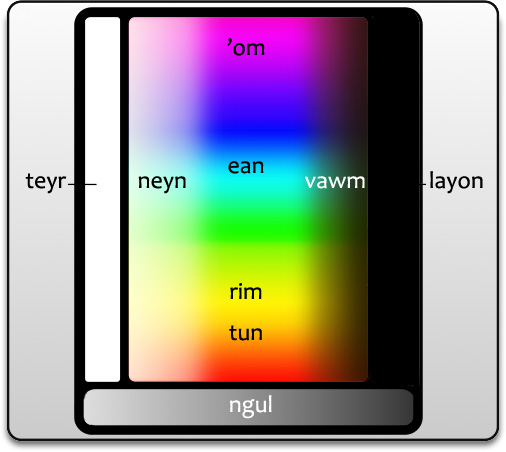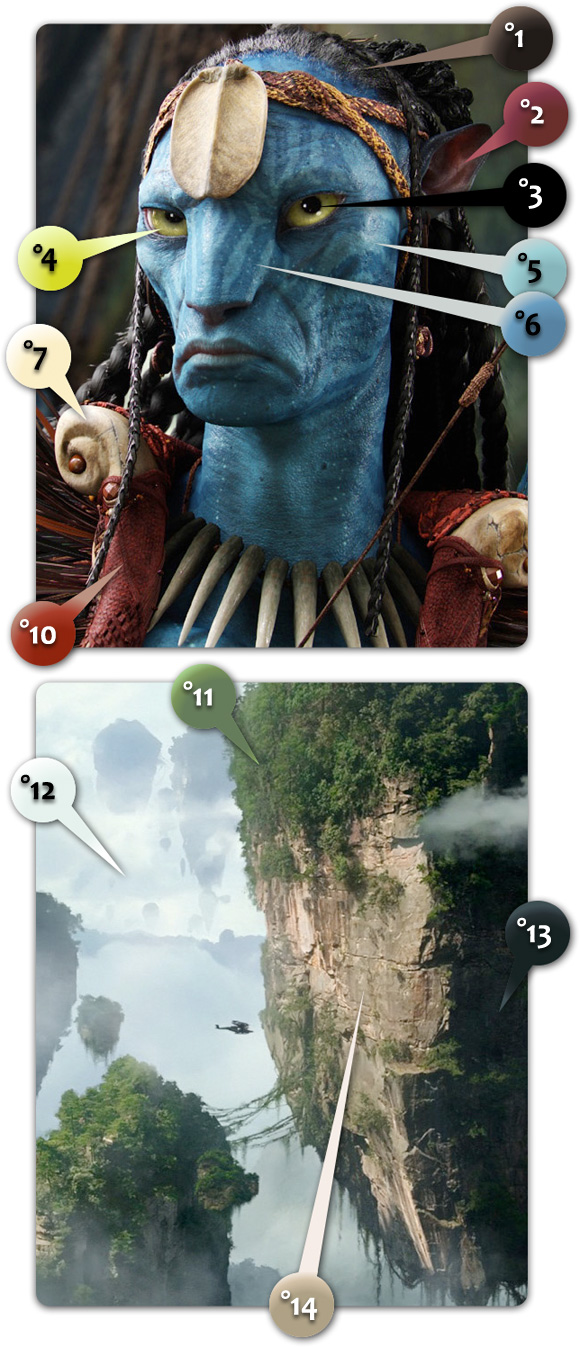. As the title says, this time I'm gonna talk about how colours work. It's a bit late, but it was requested. This post is basically a summary of the one Pawl made on his blog.
So, I think the best way to learn colours is to look at actual colours labeled by the Na'vi words. Check out these (from Karyu Pawl's Blog):

These Na'vi colour words are broad. Most of them include a whole range of colours. This isn't too crazy, because there are many shades of blue, red, purple, etc. in English.
So the 9 basic colour words from above are:
| : | covers the red-to-orange part |
| : | yellow |
| : | covers green to blue |
| : | covers violet to purple to magenta |
| : | black |
| : | white |
| : | covers deep dark colours including browns |
| : | light colours "shades of white" |
| : | gray or drab |
All of these colour words are adjectives, not nouns. So you use them like this:
(This flower is yellow.)
(This yellow flower is the smallest of all.)
If you want to use the noun, add -pin onto the end of the colour word, like this:
(I don’t like the colour yellow.)
If you want to be more specific, you compare the colour with something. We do this in English: leaf green, sky blue, brick red, etc. in Na'vi, use (like,as):
(This flower is blue like skin.)
-OR-
(This flower is blue like skin.)
To say This skin-blue flower is very beautiful, you have 4 choices:
(There are actually more choices, if you move the part around.)
You are free to come up with these comparisons with on your own, as long as there’s good reason to expect that you'll be understood.
Here are some more examples:

| º1: | (the dark colour of Na’vi hair) | |
| º2: | (the purplish colour on the inside of a Na’vi ear) | |
| º3: | (layon and teyr are not really changeable except in poetry.) |
Layon is solid black, the total absence of colour; teyr is pure white.
| º4: | (Although there are lots of different kinds of eyes on Pandora, in the absence of further specification it’s understand here that nari means nari leNa’vi.) | |
| º5: | (skin-blue) | |
| º6: | (facial-stripe blue) | |
| º7: | (the light colour of bone) | |
| º10: | (leader red, the reddish colour that distinguishes the dress of Na’vi leaders) | |
| º11: | (green, as on earth, not all leaves are green, but most are. Ean na rìk and ean na ta’leng are the most common ways to distinguish green from blue.) | |
| º12: | (the light, nondescript colour of mist or fog) | |
| º13: | (dark-shadow colour) | |
| º14: | (the drab colour of stone) |
Some of these na- colour things are so common, they are shortened:
>
>
> (brown)
But those you can't come up with on your own; they're all listed in the dictionary.
So if you thought that the numbering was weird in that list up there, that I somehow forgot eight and nine and skipped to ten, that's not what happened. And there's a reason for a degree sign around the numbers. So next post, I'll talk about Na'vi numbers and how to count and stuff.
This site is not affiliated with the official Avatar website, James Cameron, Lightstorm Entertainment or the Twentieth Century Fox Film Corporation. All Trademarks and Servicemarks are the properties of their respective owners.
'Ivong Na'vi!